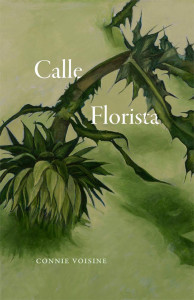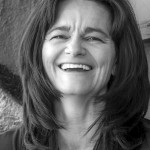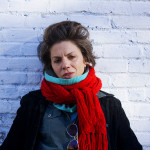Connie Voisine

Conley: Can you talk about your coming into poetry, and how your own relationship to more than one spoken language has (if at all) played a role in how you handle English.
Voisine: No doubt there were a couple of main factors—the first is the way that reading affected me. My earliest memories of reading chapter books involve lounging on the green couch in the darkish living room all day Saturday. My mother begged me to go outside with my sisters who were probably playing in the barn with the pigs, or in the summer fields of clover, or riding bike down our steep driveway. I could read for hours (sedentary nature? escapist leanings?). My eyes flowed over the pages quickly and capably. I lived better with words—Laura Ingalls Wilder made me think about food, travel, aloneness with nature, and fear in my own life. My world became articulate and more vivid because of those books.
The second factor was agency, my own of course. It was something I put on, like a costume, when I was 28 years old: I will be a writer. I had lost much of my confidence and my sense of pleasure I had in childhood. As a female, as a working class person, I pretended that I believed writing was possible. I still admire the poets who seem so sure. But that could be their costume, too.
My family and people in Maine speak French because our village is on the border with New Brunswick’s western, French part. Learning English later, and then from people who themselves spoke it as a second language, I learned an English that had a different music or tone. Also, I am never confident enough about prepositions. That said, these days I am living in Northern Ireland which constantly reinvigorates my relationship to English. For example, “’Bout ye?” is a common greeting. As in, “What about you?” Not that. “What’s up?” maybe.
Conley: Your latest book, Calle Florista, invests much of its attention on location, including landscape and more broadly, places or historical contexts in which the speaker has some vested interest. Can you say more about how location figures as a starting point (or end / through point) in your poems?
Voisine: How can the place in which you live NOT matter? Growing up where I did absolutely formed me and scholarships to a place like Yale changed me in ways I am still trying to figure out. I could not imagine any other subject.
In Calle Florista, I needed to write about the desert because it was utterly foreign to me as a New Englander. Also, I had all kinds of questions along the lines of “who the hell am I to write about this place?” After all, this was not my land—I know people whose families have lived in New Mexico for hundreds of years or more. Also, I am no nature writer or, at the least, I haven’t figured that subject matter out for myself. Therefore, the problem I was faced with as a poet was what to do with that painful, bright, desert sun? the dangerousness of its heat? the miles of scrub and sky? It took me a long time to find my footing, poetically speaking, but in the end, something got whittled down for me, in my language and intention. Furthermore, the desert of the Psalms had been evocative to me as long as I can remember, “the mountains skipped like rams, and the little hills like lambs.” (How great is that?) And what part of the mind, what new way of seeing was opening up for me in that desert place? Somewhere along the struggle, I entered into a desert mind. Transtromer has that “mind of winter” in his work, and as a northerner I felt connected to it because of that mind from the start. It’s hard to point to what and how and where that happens in his poems. The “mind of desert” was part of my task for this book.
Recently, this rootedness in place has somewhat changed for me. Deeper still in the lyric mode, I keep thinking about my speaker’s location in her body as more important than anything else, which seems a significant change from my usual practice. The environment of the female body, as I approach my middle ages, is THE formative experience from which I write. I realize I have not spent enough time planning what turning 50, 60, 70, or 80 while female should be. In our culture, especially, this is difficult terrain to negotiate. You and I, Francine, have been lucky to be involved with Warren Wilson’s MFA program where fierce and female are connected across the years. When in doubt, read Ellen Bryant Voigt, Eleanor Wilner, Marianne Boruch, Martha Rhodes, all of that fine faculty. There are four MacArthur fellows teaching there, and they are all women—not bad at all.
Conley: In what specific ways did Calle Florista take you to new places after your two earlier works, Rare High Meadow of Which I Might Dream (2008), Cathedral of the North (2001)?
Voisine: Here’s the little map, perhaps.
Start with the usual retrospective, autobiographical narrativish, “development of the poet” book; move into the shock of “adulting” book, and the long line that allows speculation, narrative and fanciness; and then, weary of the self, let go of all that and try to let metaphor do more of the heavy lifting while experimenting with how little of the backstory is necessary for a metaphor to work.
I stripped things down and relaxed my diction in this new book. Sometimes I fear it’s too plain, and that the difficulties I had figuring out its mode is too obviously imbedded in the work. Maybe writing one book creates a formal uncomfortability that only is resolved in the next book. The itch that needs to be scratched.
Also, metaphor emerged more fully as a tool for me in Calle Florista. I had not leaned so much on metaphor in years. I remember writing obscure poems in high school consisting only of mysterious metaphors. Metaphor as what drew me to poetry in the first place. Raised Catholic, I loved the symbolism, the metaphors of bread and wine, the mustard seed, the ark. (Calling those “metaphors’” might be considered blasphemous but Sister Annie’s 4th grade catechism class was truly my introduction to magical metaphor.) I kept moving the metaphor farther and closer to experience in these poems partly because what I wanted to express about life in the desert southwest felt inexpressible, or very difficult to pin down at the least.
Other poets who’ve influenced this book are those of Eastern Europe: Szymborska, Herbert, Milosz, Holan, and Flora, specifically. I get something about humans without relying so much on confession; a particular personality is not the subject of these kinds of lyric poems. To me, this is an appealing tactic for tackling some of the issues of the post-romantic lyric.
Conley: In Calle Florista a number of poems like “New World,” and “Psalm to Whoever is Responsible,” have a “non-sequitor” feel about them, in the sense that each line jolts the reader out of one logic and into another. Can you say more about the dramatic interest you craft into poems like these that unabashedly swerve to and fro?
Voisine: Swerve is a nice word for this. Juxtaposition sounds a bit medical. Leaping sounds fanciful, and tipsy is not it at all. I often get stuck thinking about the dramatic syntax of a poem, how from beginning to middle to end, the thing must move. I had forgotten how, in a short lyric, the experience is so intensely curated by the writer to increase the drama of its information. Poem as delivery system. Working on this book I often separated all the sentences and literally cut them from each other, and switched them around like puzzle pieces, or Scrabble tiles. I wanted to have the reader feel surprised by each new line of thought, or image, or enjambment, though I didn’t want that surprise to be too destabilizing or illogical. The order had to make sense, or follow its own logic, but there had to be some change with each new sentence. Some sentences (or clauses) became irrelevant in the process. Others seemed necessary.
Having had so many difficulties pinning down the mood, feelings and ideas for these poems, I found those narrated transitions that I had leaned on quite heavily in Rare High Meadow of Which I Might Dream were just too difficult and truly flattened the material. Plus, a word to the wise: avoiding desert cliché is really harder than it sounds; avoiding didacticism is too! A poet like Milosz can pull it off, but me, I am not quite there yet. C. K. Williams taught me much about those kinds of transitions, but I couldn’t do them in this book without feeling that I’d just deflated the poem. I had been reading lots of Mary Ruefle and Mary Szybist too, who seem to privilege the swerve, the magical mojo of not explaining.
Conley: To that end, say if you can, more about the poetics of influence, or — how you learned to move and what keeps moving you? Do poems chase you down? Do you run into them? Do you go for long walks and piece and meal them?
Voisine: I must chase those poems, because there’s always something else pressing for my time. It’s a prioritization that is hard to manage sometimes, though I always feel saner and more capable after having written. I love to read a poem and think about that poem while I write my own. Terrance Hayes for language lately, Leonita Flynn for a formal sense (Northern Irish). I love Reginald Shepherd for lushness, a big loss, his early death. Carl Philips for syntax. Cop shows on Netflix are doing something in my brain lately. I use them as one might use a cocktail, to loosen up my hold on this world and its hold on me. The opera of justice is one I love.
Conley: Since we share a mutual love of Louise Bourgeois, or since she figures as one of our bridge points, can you describe what her work does to you in a way that syntax could? I’ve already mentioned to you my love of her giving license to artists who return again and again to the same subject matter, as she plumbed childhood and each time made the matter of it matter otherwise.
Voisine: To me, hers is an emotional syntax. Symbol, metaphor too. She wants to enter the scary parts of the heart without a lot of interference from the logical side of the brain. Those rooms? Those spiders? Those soft shapes and hard metals? I can’t even say why or how lots of the time (maybe there’s a good anthology—get women who are Louise fans to talk about Louise). Also, let’s talk about a woman who just kept gaining in artistic power as she drew older! I love seeing a picture of her with some cape or fur and that Norman-ish white collar she seemed fond of. She’ll be smiling away with her wrinkled face whilst holding a large, organic looking sculpture of a penis under her arm. The feathers of her sleeves providing a hairiness to the phallus. The eyes twinkle. GO, Louise! And you are absolutely right—though her material could be called the same over the years, the art is rich and surprising. I would gladly take her kind of career for my own artistic long haul.
 Connie Voisine grew up in Maine and earned a BA in American studies from Yale University. She lived in New York City, studying writing at the New School and the Writers Studio, before earning her MFA from the University of California, Irvine, and PhD from the University of Utah. Her first collection, Cathedral of the North (2001), won the Association of Writers & Writing Programs Award Series in Poetry, and her second, Rare High Meadow of Which I Might Dream (2008), was a Los Angeles Times Book Award finalist. Her new book is Calle Florista (2016).
Connie Voisine grew up in Maine and earned a BA in American studies from Yale University. She lived in New York City, studying writing at the New School and the Writers Studio, before earning her MFA from the University of California, Irvine, and PhD from the University of Utah. Her first collection, Cathedral of the North (2001), won the Association of Writers & Writing Programs Award Series in Poetry, and her second, Rare High Meadow of Which I Might Dream (2008), was a Los Angeles Times Book Award finalist. Her new book is Calle Florista (2016).
 Francine Conley ––poet, performer, and director––has a chapbook of poems, How Dumb the Stars through Parallel Press (2001). Recent poems have appeared or are forthcoming in such places as: American Literary Review, The New England Review, Collagist, Juked, Paris-Atlantic, Shadowgraph Magazine, Asteri(x) Journal, Naugatuck Review, Hartskill Review, Palaver. She was a founding member of the Franco-American touring theatre company, Le Theatre de la Chandelle Verte 2001-2014, and has otherwise written, produced and performed ten one-woman multimedia productions, including her latest, The Narrow Road (2015-16). For more on her art: http://francineconley.com
Francine Conley ––poet, performer, and director––has a chapbook of poems, How Dumb the Stars through Parallel Press (2001). Recent poems have appeared or are forthcoming in such places as: American Literary Review, The New England Review, Collagist, Juked, Paris-Atlantic, Shadowgraph Magazine, Asteri(x) Journal, Naugatuck Review, Hartskill Review, Palaver. She was a founding member of the Franco-American touring theatre company, Le Theatre de la Chandelle Verte 2001-2014, and has otherwise written, produced and performed ten one-woman multimedia productions, including her latest, The Narrow Road (2015-16). For more on her art: http://francineconley.com
